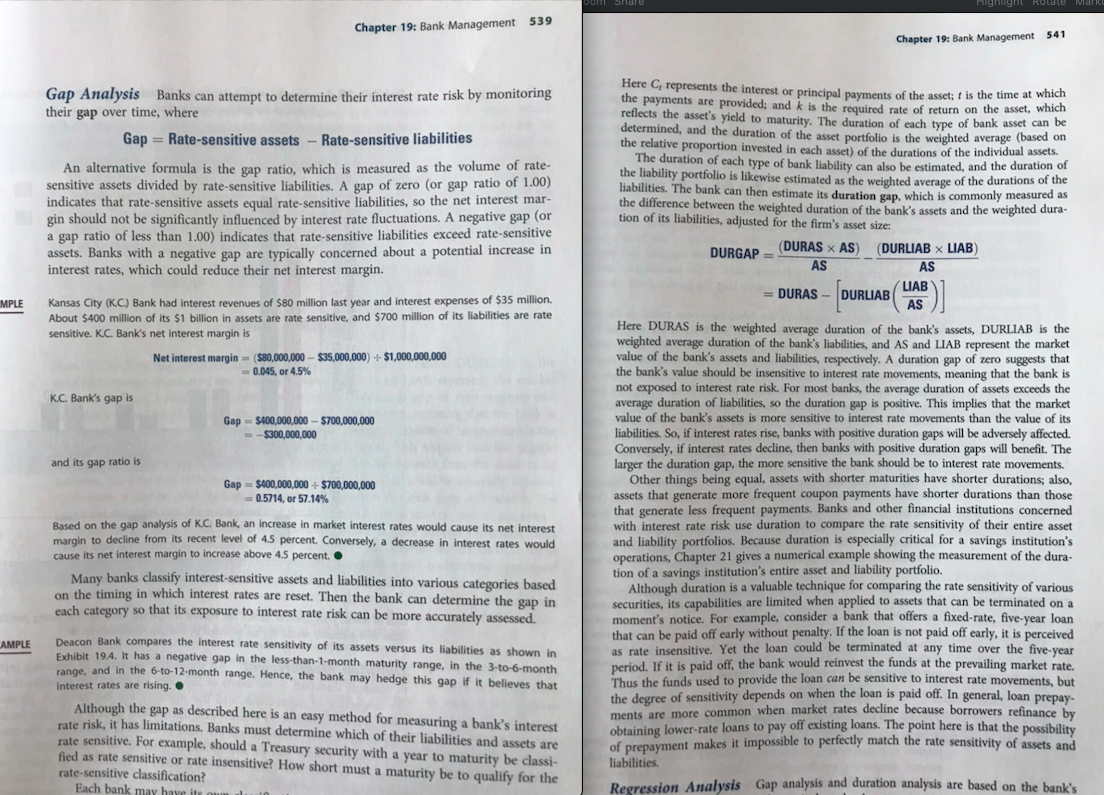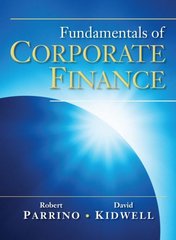Question
1. The portfolio managers of a firm determined that over the next year interest-sensitive assets are in the amount of $1.5 billion while interest-sensitive liabilities
1. The portfolio managers of a firm determined that over the next year interest-sensitive assets are in the amount of $1.5 billion while interest-sensitive liabilities are in the amount of $1.8 billion. Moreover, when considering all of the firm's assets and liabilities, they determined that the average duration of assets is 3.6 years while the average duration of liabilities is 4.0 years. The firms debt-to-equity ratio is 4-to-1.
A) Calculate GAP and Duration GAP (DGAP) for this situation. (See Chapter 19 of the Madura text for a description and example of these calculations).

My Answer: Would this be right? Based on above:
According to the textbook: GAP = Rate-sensitive assets - Rate-sensitive Liabilities
Rate-sensitive assets = 1.5 billion
Rate-sensitive Liabilities = 1.8 billion
GAP = 1.5 Billion 1.8 Billion
GAP = -.3 Billion
According to the textbook: DURGAP = DurAS [DurLiab * ( Liab/AS)]
DurAS = 3.6 years
DurLiab= 4.0 years
Liab = 1.8 Billion
AS = 1.5 Billion
DURGAP = 3.6 years [4.0 years * (1.8B/1.5B)
DURGAP = -1.20 years
B) What will happen to net interest income and relative asset prices (market values) as interest rates rise or fall?
(In other words, how are net income and overall market value impacted by changes in interest rates?)
C) What strategies could management employ to hedge against this risk? For instance, should it buy or sell futures, call options or put options (i.e., for each derivative is it a buy or sell strategy?)?
Share Chapter 19: Bank Management 539 Chapter 19: Bank Management 541 Gap Analysis Banks can attempt to determine their interest rate risk by monitoring their gap over time, where Gap = Rate-sensitive assets Rate-sensitive liabilities An alternative formula is the gap ratio, which is measured as the volume of rate- sensitive assets divided by rate-sensitive liabilities. A gap of zero (or gap ratio of 1.00) indicates that rate-sensitive assets equal rate-sensitive liabilities, so the net interest mar- gin should not be significantly influenced by interest rate fluctuations. A negative gap (or a gap ratio of less than 1.00) indicates that rate-sensitive liabilities exceed rate-sensitive assets. Banks with a negative gap are typically concerned about a potential increase in interest rates, which could reduce their net interest margin. )] MPLE Kansas City (K.C.) Bank had interest revenues of $80 million last year and interest expenses of $35 million. About $400 million of its $1 billion in assets are rate sensitive, and $700 million of its liabilities are rate sensitive. K.C. Bank's net interest margin is Net interest margin ($80,000,000 - $35,000,000) = $1,000,000,000 0.045, or 4.5% K.C. Bank's gap is Gap = $400,000,000 - $700,000,000 -$300,000,000 Here Crepresents the interest or principal payments of the asset; t is the time at which reflects the asset's yield to maturity. The duration of each type of bank asset can be determined, and the duration of the asset portfolio is the weighted average (based on the relative proportion invested in each asset) of the durations of the individual assets. The duration of each type of bank liability can also be estimated, and the duration of the liability portfolio is likewise estimated as the weighted average of the durations of the liabilities. The bank can then estimate its duration gap, which is commonly measured as the difference between the weighted duration of the bank's assets and the weighted dura- tion of its liabilities, adjusted for the firm's asset size: DURGAP = (DURAS x AS (DURLIAB x LIAB AS AS LIAB = DURAS - DURLIAB AS Here DURAS is the weighted average duration of the bank's assets, DURLIAB is the weighted average duration of the bank's liabilities, and AS and LIAB represent the market value of the bank's assets and liabilities, respectively. A duration gap of zero suggests that the bank's value should be insensitive to interest rate movements, meaning that the bank is not exposed to interest rate risk. For most banks, the average duration of assets exceeds the average duration of liabilities, so the duration gap is positive. This implies that the market value of the bank's assets is more sensitive to interest rate movements than the value e of f its liabilities. So, if interest rates rise, banks with positive duration gaps will be adversely affected. Conversely, if interest rates decline, then banks with positive duration gaps will benefit. The larger the duration gap, the more sensitive the bank should be to interest rate movements. Other things being equal, assets with shorter maturities have shorter durations; also, assets that generate more frequent coupon payments have shorter durations than those that generate less frequent payments. Banks and other financial institutions concerned with interest rate risk use duration to compare the rate sensitivity of their entire asset and liability portfolios. Because duration is especially critical for a savings institution's operations, Chapter 21 gives a numerical example showing the measurement of the dura- tion of a savings institution's entire asset and liability portfolio. Although duration is a valuable technique for comparing the rate sensitivity of various securities, its capabilities are limited when applied to assets that can be terminated on a moment's notice. For example, consider a bank that offers a fixed-rate, five-year loan that can be paid off early without penalty. If the loan is not paid off early, it is perceived period. If it is paid off, the bank would reinvest the funds at the prevailing market rate. Thus the funds used to provide the loan can be sensitive to interest rate movements, but sensitivity depends on when the loan is paid off. In general, loan prepay- ments are more common when market rates decline because borrowers refinance by obtaining lower-rate loans to pay off existing loans. The point here is that the possibility of prepayment makes it impossible to perfectly match the rate sensitivity of assets and liabilities Regression Analysis Gap analysis and duration analysis are based on the bank's and its gap ratio is Gap = $400,000,000 $700,000,000 = 0.5714, or 57.14% Based on the gap analysis of K.C. Bank, an increase market interest rates would cause its net interest margin to decline from its recent level of 4.5 percent. Conversely, a decrease in interest rates would cause its net interest margin to increase above 4.5 percent. Many banks classify interest-sensitive assets and liabilities into various categories based on the timing in which interest rates are reset. Then the bank can determine the gap in each category so that its exposure to interest rate risk can be more accurately assessed. AMPLE as Deacon Bank compares the interest rate sensitivity of its assets versus its liabilities as shown in Exhibit 19.4. It has a negative gap in the less-than-1-month maturity range, in the 3-to-6- month range, and in the 6-to-12-month range. Hence, the bank may hedge this gap if it believes that interest rates are rising. the degree Although the gap as described here is an easy method for measuring a bank's interest rate risk, it has limitations. Banks must determine which of their liabilities and assets are rate sensitive. For example, should a Treasury security with a year to maturity be classi- fied as rate sensitive or rate insensitive? How short must a maturity be to qualify for the rate-sensitive classification? Each bank may haveStep by Step Solution
There are 3 Steps involved in it
Step: 1

Get Instant Access to Expert-Tailored Solutions
See step-by-step solutions with expert insights and AI powered tools for academic success
Step: 2

Step: 3

Ace Your Homework with AI
Get the answers you need in no time with our AI-driven, step-by-step assistance
Get Started


